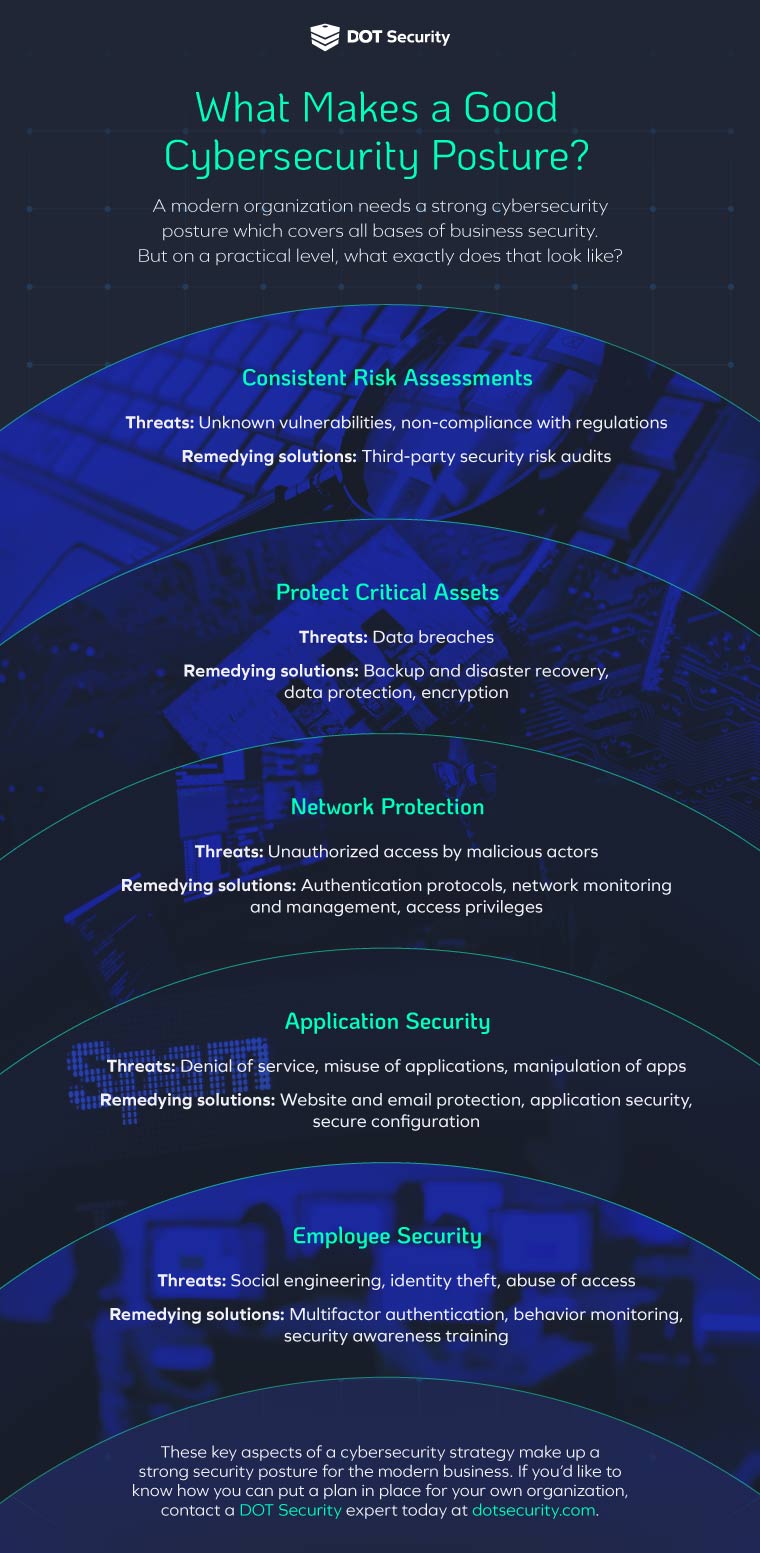Cybersecurity Consulting
Infographic: What Makes a Good Cybersecurity Posture?
March 01, 2022
5 minutes

What is a cybersecurity posture? It’s the state of a company’s overall cybersecurity strategies and protocols, including their software, hardware, and the extent to which their employees are aware of and can defend against threats.
That’s why it’s crucial to evaluate every aspect of your business’ posture and make sure it’s as strong as possible. But do you know what actually constitutes a good one?
Sign up for our newsletter!
This infographic is here to help. We break down what is actually required to have strong cybersecurity into practical, actionable steps against which you can measure your own company’s strategy.
Take a look!

Elements of a Good Cybersecurity Posture
Consistent Risk Assessments
Risk assessments, particularly those from third-parties like DOT Security, serve a couple of purposes.
First, they provide an impartial view into your current cybersecurity plan. If you’re not quite sure where your network might be vulnerable to attack, a risk assessment is the safest and surest way to find out.
Plus, you’ll also receive recommendations specific to your organization about how to fortify those areas in ways that will fit your business’ overall goals now and in the future.
Additionally, they ensure that your organization is compliant with any relevant cybersecurity regulations. No matter what state or industry you’re in, you may be subject to data privacy or security laws. A risk assessment will ensure that your cybersecurity is strong enough to meet all of them.
It’s well-known that “knowledge is power.” When it comes to having a good cybersecurity posture, you get that power from receiving regular third-party risk assessments.
Related Post: The Importance of Data Compliance Today
Protect Critical Assets
No matter the size of your business, someone will eventually attempt to steal your data. 43% of cyberattacks target SMBs, and 60% of small businesses are forced to close within six months of an attack. As long as the data you're storing is valuable to you – let alone your customers – the risk of a data breach is real and must be protected against.
That’s where solutions like data protection, encryption, and backup and disaster recovery come into play in a good cybersecurity posture.
Secure data protection is an extra layer of coverage around your most sensitive data. It includes tools that protect that information as it’s traveling to and from the cloud and among employees. It also involves employee training so they know not to leak sensitive information to anyone.
Encryption is a tool that scrambles delicate customer data as it travels, so even if a bad actor were to obtain it, they wouldn’t be able to use or make any sense out of it.
And, in the worst-case scenario, a backup and disaster recovery plan can minimize your downtime in the event of a breach, get your system back up and running again, and includes backups of all your files to reduce the impact of a ransomware attack.
Network Protection
Modern cybersecurity software is extremely advanced. Next-gen antivirus can not only detect known viruses, but also defend against new ones that haven’t been discovered yet! That means it’s far easier for a hacker to steal real credentials than try to break into your system to cause trouble.
You can defend against this by having strong authentication protocols in place, like extensive password policies, so it’s harder for a cybercriminal to figure out your employees’ credentials.
Pair that with stringent access management rules to ensure that the only people who receive information are those that need to have it, and it’s not available for any vulnerable account to read or download.
Bolster those with expert network monitoring. If someone trusted is consistently examining your system, they’ll be able to notice when an account is acting weirdly or someone is accessing information they shouldn’t have. If it is a breach, that quick detection gives your cybersecurity team the best chance of removing the attacker and minimizing the damage.
Application Security
We use all kinds of applications in all kinds of ways, and they make life at work so much easier. But they can also be famously simple for hackers to exploit with denial-of-service attacks among others.
76% of mobile apps have critical vulnerabilities in their security.
Even if they don’t get hacked in the traditional sense, apps can still be easily misused or manipulated to let bad actors see all kinds of information.
That’s why website and email protection is part of any good cybersecurity posture, including anything from spam filters to Web Application Firewalls.
It’s also important to make sure that all of your apps have a secure configuration. This means using apps that you know are created with cybersecurity in mind, utilize encryption, and have secure authentication protocols in place, at a minimum.
Employee Security
90% of all breaches can be ultimately attributed to human error, and phishing attempts have grown more sophisticated than ever, giving hackers access to employee credentials, and sometimes their entire identity. Even worse, some of those employee-related breaches aren’t an accident; a significant number of breaches are deliberate inside jobs.
Implement solutions like employee awareness training and behavior monitoring to counteract these threats.
An informed workforce is much better at spotting and stopping attacks designed to take their information than one that’s left to fend for itself.
If you know the way your employees typically behave on your network, then you’ll be able to spot when their patterns change and keep an eye out for malicious activity.
And just in case, multi-factor authentication software makes it much harder for hackers to access your system, even if they’ve managed to steal active usernames and passwords.
Do you want to improve your organization’s cybersecurity posture but don’t know where to begin? Consider starting with a DOT Security Risk Assessment to learn what your business needs to improve the most and get recommendations on the right solutions for your situation. Contact a DOT Security specialist today.
